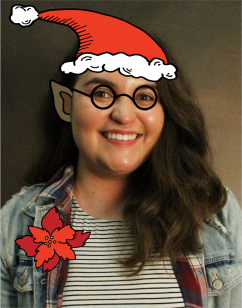Half-eaten leftover cookies. A signed note. Boot marks in the snow. Presents under the tree.
I was obsessed with Christmas and jolly old Santa Claus growing up. Quite frankly, I still am.
Even though toys were an obvious joy of Christmas, my favorite aspect of the season was attempting to catch Santa each and every year. My 5-year-old brain was convinced I could catch the man in the red suit and prove his realness or illusion.
But my 5-year-old brain also clocked out at 8 p.m., making it a bit difficult to really find the man in action.

Still, being the gullible person I am, I held onto the belief I could truly catch Santa until I was 11 years old. I know — I held on longer than most children. I really should have known it was all a myth when my mother explained Santa enjoyed Diet Coke and coffee more than milk.

Hailey Stewart | Argonaut
Even though my dreams were eventually crushed like a candy cane left in a coat pocket, I find those years as a child during the holidays to be some of my most magical memories.
My parents put in the work each Christmas. There was always a note in very Santa-like handwriting, a dusting of magic glitter scattered in front of our tree and a jingle of bells while I was just awake enough to notice.
Now with smaller siblings, I have yet to go a year without even just a bit of Santa-related magic. Without always recognizing it, the magic of giving has become part of my life, just like many others around the world.
While there is no right or wrong way to spend the Christmas season, a hefty dose of magic never seems to hurt. Santa, even with all the commercialization, can provide that for children young and old.
Some people find out rather early in their lives, while others are more like me. For some children, they learn of Santa’s fictitious life without even seeking the answer.
In one New Jersey elementary school, some children found out the hard way that Santa isn’t all he’s cracked up to be when a substitute teacher told students the red-suited man wasn’t real and the presents the find under the tree are all from their parents.
“If the conversation comes up at home over the next few days you can take appropriate steps to maintain the childhood innocence of the holiday season,” the school’s principal wrote in the letter, as reported by NBC.
While the tooth fairy and Easter bunny take a backseat to Santa, the substitute even told the students they didn’t exist either. Talk about a traumatic day in the second grade.
Even if the substitute meant to be truthful with her students, the season must definitely have a bit of a damper on it this time around for some of them.
Aside from the obvious lying to children and the rather overly materialistic aspects that come with believing in Santa, there are most definitely positives that come with it.
After my — maybe too long of a time — believing in Santa, I feel the same excitement to give that joy to my younger siblings.
Now, I get to be part of the half-eaten leftover cookies, the signed notes, the boot marks in the snow and arranging the presents under the tree. I get to help keep the tradition alive, even if it’s just for a short while.
Hailey Stewart can be reached at [email protected] or on Twitter at @HaileyAStew
Read the opposing view here.
